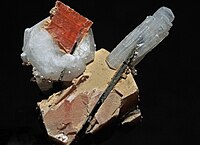
Photo from wikipedia
Abstract At the moment, it is vital for mineral industries to abide environmental regulation to dispose of the wastes generated in the beneficiation process. The redesign of dewatering process is… Click to show full abstract
Abstract At the moment, it is vital for mineral industries to abide environmental regulation to dispose of the wastes generated in the beneficiation process. The redesign of dewatering process is required to meet the present demand. This paper reports the results of systematic investigations on the flocculation, sedimentation and consolidation characteristics of the chromite ore process tailings using different polyacrylamide flocculants. Laboratory batch sedimentation tests were performed to assess the performance of flocculants. Different categories of flocculants such as anionic, cationic, non-ionic with varying ionicity and molecular mass were used to improve the settling rate. The influence of flocculants on the settling rate, solid consolidation, and supernatant liquid clarity was recorded. Ionicity and molecular weight of the flocculants have a significant effect on the tailings settling properties. Anionic flocculants with low ionic strength and molecular weight show higher settling efficiency, whereas, cationic flocculants bearing high ionic strength and molecular weight also display the similar settling behaviour. The opaqueness of consolidated solids is greater with cationic than the anionic polyacrylamide. The anionic Alstafloc 40, 60 and cationic Alstafloc 155XX have exhibited excellent turbidity removal efficiency with 19.5 cm/min settling rate at 15 g polymer/tonne solid dosage. The non-ionic polyacrylamide was not found efficient for the tailings flocculation.
Journal Title: Colloids and Surfaces A: Physicochemical and Engineering Aspects
Year Published: 2018
Link to full text (if available)
Share on Social Media: Sign Up to like & get
recommendations!